Integrating Metabolomics and Network Pharmacology to Decipher the Hepatoprotective Effect Mechanisms of Magnesium Isoglycyrrhizinate Injection
Abstract
:1. Introduction
2. Materials and Methods
2.1. Instrument, Drugs, and Material
2.2. Animals and Ethics Statement
2.3. Sample Collection
2.4. Biochemical Index Detection and Histopathology
2.5. Metabolomics Analysis
2.5.1. Sample Preparation
2.5.2. UHPLC-QTOF/MS Conditions
2.5.3. Statistical Analysis
2.6. Network Pharmacology
2.6.1. Drug Target Prediction
2.6.2. Disease Target Collection
2.6.3. Construction and Analysis of Protein Target Interaction PPI Network
2.6.4. GO and KEGG Path Analysis
2.6.5. Molecular Docking
2.7. Protein Expression Was Verified by Western Blot Analysis
3. Results
3.1. Effects of MII on ALT, AST and SOD Levels in the Serum of Mice with Liver Injury
3.2. Effect of MII on Liver Histopathology in Mice with Liver Injury
3.3. Metabolomics Analysis
3.3.1. Multivariate Statistical Analysis
3.3.2. Analysis of Method Stability
3.3.3. Potential Biomarker Screening
3.3.4. Metabolic Pathway Analysis
3.4. Network Pharmacological Analysis
3.4.1. Analysis of Targets of MII and Drug-Induced Liver Injury
3.4.2. Construction of PPI Network in MII Treatment of Liver Injury
3.4.3. Analysis of Key Targets of MII in the Treatment of Liver Injury
3.4.4. Analysis of GO and KEGG Enrichment Results in MII Treatment of Liver Injury
3.4.5. Molecular Docking
3.5. Effects of MII on the Expression of JAK2 and STAT3 in the Liver Tissue of Mice with Liver Injury
4. Discussion
5. Conclusions
Supplementary Materials
Author Contributions
Funding
Institutional Review Board Statement
Informed Consent Statement
Data Availability Statement
Acknowledgments
Conflicts of Interest
References
- Kubes, P.; Jenne, C. Immune Responses in the Liver. Annu. Rev. Immunol. 2018, 36, 247–277. [Google Scholar] [CrossRef] [PubMed]
- Li, X.J.Y.; Liu, R.P.; Zhang, L.Y.; Jiang, Z.Z. The emerging role of AMP-activated protein kinase in cholestatic liver diseases. Pharmacol. Res. 2017, 125 Pt B, 105–113. [Google Scholar] [CrossRef]
- Norman, B.H. Drug Induced Liver Injury (DILI). Mechanisms and Medicinal Chemistry Avoidance/Mitigation Strategies. J. Med. Chem. 2020, 63, 11397–11419. [Google Scholar] [CrossRef] [PubMed]
- Lee, W.M. Drug-induced hepatotoxicity. N. Engl. J. Med. 2003, 349, 474–485. [Google Scholar] [CrossRef] [PubMed]
- Jaeschke, H.; Akakpo, J.Y.; Umbaugh, D.S.; Ramachandran, A. Novel Therapeutic Approaches Against Acetaminophen-induced Liver Injury and Acute Liver Failure. Toxicol. Sci. 2020, 174, 159–167. [Google Scholar] [CrossRef] [PubMed]
- Fisher, E.S.; Curry, S.C. Evaluation and treatment of acetaminophen toxicity. Adv. Pharmacol. 2019, 85, 263–272. [Google Scholar] [PubMed]
- Yan, M.; Huo, Y.; Yin, S.; Hu, H. Mechanisms of acetaminophen-induced liver injury and its implications for therapeutic interventions. Redox Biol. 2018, 17, 274–283. [Google Scholar] [CrossRef] [PubMed]
- Chang, L.; Xu, D.W.; Zhu, J.J.; Ge, G.B.; Zhou, Y. Herbal Therapy for the Treatment of Acetaminophen-Associated Liver Injury: Recent Advances and Future Perspectives. Front. Pharmacol. 2020, 11, 313. [Google Scholar] [CrossRef]
- Gwak, G.Y.; Moon, T.G.; Lee, D.H.; Yoo, B.C. Glycyrrhizin attenuates HMGB1-induced hepatocyte apoptosis by inhibiting the p38-dependent mitochondrial pathway. World J. Gastroenterol. 2012, 18, 679–684. [Google Scholar] [CrossRef]
- Li, X.; Sun, R.; Liu, R. Natural products in licorice for the therapy of liver diseases: Progress and future opportunities. Pharmacol. Res. 2019, 144, 210–226. [Google Scholar] [CrossRef]
- Hasan, S.K.; Khan, R.; Ali, N.; Khan, A.Q.; Rehman, M.U.; Tahir, M.; Lateef, A.; Nafees, S.; Mehdi, S.J.; Rashid, S.; et al. 18-β Glycyrrhetinic acid alleviates 2-acetylaminofluorene-induced hepatotoxicity in Wistar rats: Role in hyperproliferation, inflammation and oxidative stress. Hum. Exp. Toxicol. 2015, 34, 628–641. [Google Scholar] [CrossRef] [PubMed]
- Sun, Z.G.; Zhao, T.T.; Lu, N.; Yang, Y.A.; Zhu, H.L. Research Progress of Glycyrrhizic Acid on Antiviral Activity. Mini Rev. Med. Chem. 2019, 19, 826–832. [Google Scholar] [CrossRef] [PubMed]
- Bailly, C.; Vergoten, G. Glycyrrhizin: An alternative drug for the treatment of COVID-19 infection and the associated respiratory syndrome. Pharmacol. Ther. 2020, 214, 107618. [Google Scholar] [CrossRef] [PubMed]
- Zhu, K.; Zhu, X.; Liu, S.; Yu, J.; Wu, S.; Hei, M. Glycyrrhizin Attenuates Hypoxic-Ischemic Brain Damage by Inhibiting Ferroptosis and Neuroinflammation in Neonatal Rats via the HMGB1/GPX4 Pathway. Oxid. Med. Cell Longev. 2022, 2022, 8438528. [Google Scholar] [CrossRef] [PubMed]
- Jain, R.; Hussein, M.A.; Pierce, S.; Martens, C.; Shahagadkar, P.; Munirathinam, G. Oncopreventive and oncotherapeutic potential of licorice triterpenoid compound glycyrrhizin and its derivatives: Molecular insights. Pharmacol. Res. 2022, 178, 106138. [Google Scholar] [CrossRef] [PubMed]
- Eu, C.H.; Lim, W.Y.; Ton, S.H.; bin Abdul Kadir, K. Glycyrrhizic acid improved lipoprotein lipase expression, insulin sensitivity, serum lipid and lipid deposition in high-fat diet-induced obese rats. Lipids Health Dis. 2010, 9, 81. [Google Scholar] [CrossRef] [PubMed]
- Tan, D.; Tseng, H.H.L.; Zhong, Z.; Wang, S.; Vong, C.T.; Wang, Y. Glycyrrhizic Acid and Its Derivatives: Promising Candidates for the Management of Type 2 Diabetes Mellitus and Its Complications. Int. J. Mol. Sci. 2022, 23, 10988. [Google Scholar] [CrossRef]
- Li, J.Y.; Cao, H.Y.; Liu, P.; Cheng, G.H.; Sun, M.Y. Glycyrrhizic acid in the treatment of liver diseases: Literature review. Biomed. Res. Int. 2014, 2014, 872139. [Google Scholar] [CrossRef]
- Chen, K.; Yang, R.; Shen, F.Q.; Zhu, H.L. Advances in Pharmacological Activities and Mechanisms of Glycyrrhizic Acid. Curr. Med. Chem. 2020, 27, 6219–6243. [Google Scholar] [CrossRef]
- Wang, L.; Yang, R.; Yuan, B.; Liu, Y.; Liu, C. The antiviral and antimicrobial activities of licorice, a widely-used Chinese herb. Acta Pharm. Sin. B 2015, 5, 310–315. [Google Scholar] [CrossRef]
- Gu, X.; Dong, L.; Liu, Y.; Yu, F. Protective Effect of Magnesium Isoglycyrrhizinate on Acute Hepatic Injury induced by CCl4 in Mice. China Pharm. 2009, 12, 37–39. [Google Scholar]
- Yang, Y.Z.; Zhao, X.J.; Xu, H.J.; Wang, S.C.; Pan, Y.; Wang, S.J.; Xu, Q.; Jiao, R.Q.; Gu, H.M.; Kong, L.D. Magnesium isoglycyrrhizinate ameliorates high fructose-induced liver fibrosis in rat by increasing miR-375-3p to suppress JAK2/STAT3 pathway and TGF-β1/Smad signaling. Acta Pharmacol. Sin. 2019, 40, 879–894. [Google Scholar] [CrossRef] [PubMed]
- Tang, G.H.; Yang, H.Y.; Zhang, J.C.; Ren, J.J.; Sang, X.T.; Lu, X.; Zhong, S.X.; Mao, Y.L. Magnesium isoglycyrrhizinate inhibits inflammatory response through STAT3 pathway to protect remnant liver function. World J. Gastroenterol. 2015, 21, 12370–12380. [Google Scholar] [CrossRef] [PubMed]
- Liu, M.; Zheng, B.; Liu, P.; Zhang, J.; Chu, X.; Dong, C.; Shi, J.; Liang, Y.; Chu, L.; Liu, Y.; et al. Exploration of the hepatoprotective effect and mechanism of magnesium isoglycyrrhizinate in mice with arsenic trioxide-induced acute liver injury. Mol. Med. Rep. 2021, 23, 438. [Google Scholar] [CrossRef] [PubMed]
- Gao, Y.D.; Tian, Y.; Zhang, X.Y.; Zhang, X.H.; Duan, Z.P.; Ren, F.; Chen, Y. Magnesium isoglycyrrhizinate ameliorates concanavalin A-induced liver injury via the p38 and JNK MAPK pathway. Immunopharmacol. Immunotoxicol. 2020, 42, 445–455. [Google Scholar] [CrossRef]
- Li, Q.; Zhang, W.; Cheng, N.; Zhu, Y.D.; Li, H.; Zhang, S.J.; Guo, W.Z.; Ge, G.B. Pectolinarigenin ameliorates acetaminophen-induced acute liver injury via attenuating oxidative stress and inflammatory response in Nrf2 and PPARα dependent manners. Phytomedicine 2023, 113, 154726. [Google Scholar] [CrossRef]
- Zhang, Y.H.; Yuan, D.D.; Yao, W.F.; Zhu, Q.Q.; Liu, Y.; Huang, F.; Feng, J.Y.; Chen, X.; Huang, Y.; Chi, X.J.; et al. Hyperglycemia Aggravates Hepatic Ischemia Reperfusion Injury by Inducing Chronic Oxidative Stress and Inflammation. Oxid. Med. Cell Longev. 2016, 2016, 3919627. [Google Scholar] [CrossRef]
- Yang, X.; Li, Y.H.; Sha, Z.G.; Li, Y.F.; Yang, C.F. Analysis of Molecular Mechanism of Coptis chinensis Franch in Prevention and Treatment of Hepatitis B and Nonalcoholic Fatty Liver Disease Based on Network Pharmacology and Molecular Docking. Her. Med. 2020, 39, 275–279. [Google Scholar]
- Rinschen, M.M.; Ivanisevic, J.; Giera, M.; Siuzdak, G. Identification of bioactive metabolites using activity metabolomics. Nat. Rev. Mol. Cell Biol. 2019, 20, 353–367. [Google Scholar] [CrossRef]
- Wishart, D.S. Metabolomics for Investigating Physiological and Pathophysiological Processes. Physiol. Rev. 2019, 99, 1819–1875. [Google Scholar] [CrossRef]
- Yang, H.Y.; Liu, M.L.; Luo, P.; Yao, X.S.; Zhou, H. Network pharmacology provides a systematic approach to understanding the treatment of ischemic heart diseases with traditional Chinese medicine. Phytomedicine 2022, 104, 154268. [Google Scholar] [CrossRef] [PubMed]
- Wang, Y.; Tian, L.; Wang, Y.; Zhao, T.; Khan, A.; Wang, Y.; Cao, J.; Cheng, G. Protective effect of Que Zui tea hot-water and aqueous ethanol extract against acetaminophen-induced liver injury in mice via inhibition of oxidative stress, inflammation, and apoptosis. Food Funct. 2021, 12, 2468–2480. [Google Scholar] [CrossRef]
- Zeeyauddin, K.; Setty, R.C.S.; Mufaqam, S.M.; Ibrahim, M. Evaluation of hepatoprotective activity of Boswellia serrata leaves extracts in albino rats. Indian. Drugs 2010, 47, 19–24. [Google Scholar]
- Zhao, R.W.; Zhang, Q.; Liu, W.J.; Lin, Y.F.; He, Y.H.; Chang, D.; Li, S.H.; Xu, W.; Lin, Y.X.; Zheng, Y.F.; et al. Pien Tze Huang attenuated acetaminophen-induced liver injury by autophagy mediated-NLRP3 inflammasome inhibition. J. Ethnopharmacol. 2023, 311, 116285. [Google Scholar] [CrossRef] [PubMed]
- Villanueva-Paz, M.; Morán, L.; López-Alcántara, N.; Freixo, C.; Andrade, R.J.; Lucena, M.I.; Cubero, F.J. Oxidative Stress in Drug-Induced Liver Injury (DILI): From Mechanisms to Biomarkers for Use in Clinical Practice. Antioxidants 2021, 10, 390. [Google Scholar] [CrossRef] [PubMed]
- Guo, H.L.; Sun, J.Y.; Li, D.Y.; Hu, Y.H.; Xu, J. Shikonin attenuates acetaminophen-induced acute liver injury via inhibition of oxidative stress and inflammation. Biomed. Pharmacother. 2019, 112, 108704. [Google Scholar] [CrossRef]
- Boon, R.; Kumar, M.; Tricot, T. Amino acid levels determine metabolism and CYP450 function of hepatocytes and hepatoma cell lines. Nat. Commun. 2020, 11, 1393. [Google Scholar] [CrossRef] [PubMed]
- Rao, Y.; Kuang, Z.; Li, C. Gut Akkermansia muciniphila ameliorates metabolic dysfunction-associated fatty liver disease by regulating the metabolism of L-aspartate via gut-liver axis. Gut Microbes 2021, 13, 1927633. [Google Scholar] [CrossRef]
- Clinton, J.W.; Kiparizoska, S.; Aggarwal, S.; Woo, S.; Davis, W.; Lewis, J.H. Drug-Induced Liver Injury: Highlights and Controversies in the Recent Literature. Drug Saf. 2021, 44, 1125–1149. [Google Scholar] [CrossRef]
- Jiménez-Torres, C.; El-Kehdy, H.; Hernández-Kelly, L.C.; Sokal, E.; Ortega, A.; Najimi, M. Acute Liver Toxicity Modifies Protein Expression of Glutamate Transporters in Liver and Cerebellar Tissue. Front. Neurosci. 2021, 14, 613225. [Google Scholar] [CrossRef]
- Li, Z.; Wang, F.; Liang, B. Methionine metabolism in chronic liver diseases: An update on molecular mechanism and therapeutic implication. Signal Transduct. Target. Ther. 2020, 5, 280. [Google Scholar] [CrossRef] [PubMed]
- Paul, B.; Lewinska, M.; Andersenm, J.B. Lipid alterations in chronic liver disease and liver cancer. JHEP Rep. 2022, 4, 100479. [Google Scholar] [CrossRef] [PubMed]
- Yangm, L.X.; Yu, S.P.; Yang, Y.H.; Wu, H.J.; Zhang, X.Y.; Lei, Y.T.; Lei, Z.L. Berberine improves liver injury induced glucose and lipid metabolic disorders via alleviating ER stress of hepatocytes and modulating gut microbiota in mice. Bioorg. Med. Chem. 2021, 55, 116598. [Google Scholar]
- Osipova, D.; Kokoreva, K.; Lazebnik, L.; Golovanova, E.; Pavlov, C.; Dukhanin, A.; Orlova, S.; Starostin, K. Regression of Liver Steatosis Following Phosphatidylcholine Administration: A Review of Molecular and Metabolic Pathways Involved. Front. Pharmacol. 2022, 13, 797923. [Google Scholar] [CrossRef]
- Green, C.D.; Maceyka, M.; Cowart, L.A.; Spiegel, S. Sphingolipids in metabolic disease: The good, the bad, and the unknown. Cell Metab. 2021, 33, 1293–1306. [Google Scholar] [CrossRef] [PubMed]
- Chaurasia, B.; Summers, S.A. Ceramides in Metabolism: Key Lipotoxic Players. Annu. Rev. Physiol. 2021, 83, 303–330. [Google Scholar] [CrossRef]
- Chen, H.Y.; Wang, J.M.; Zhang, C.Y.; Ding, P.L.; Tian, S.X.; Chen, J.M.; Ji, G.; Wu, T. Sphingosine 1-phosphate receptor, a new therapeutic direction in different diseases. Biomed. Pharmacother. 2022, 153, 113341. [Google Scholar] [CrossRef]
- Hu, Z.M.; Han, Y.M.; Liu, Y.X.; Zhao, Z.H.; Ma, F.G.; Cui, A.Y.; Zhang, F.F.; Liu, Z.S.; Xue, Y.Q.; Bai, J.Y.; et al. CREBZF as a Key Regulator of STAT3 Pathway in the Control of Liver Regeneration in Mice. Hepatology 2020, 71, 1421–1436. [Google Scholar] [CrossRef]
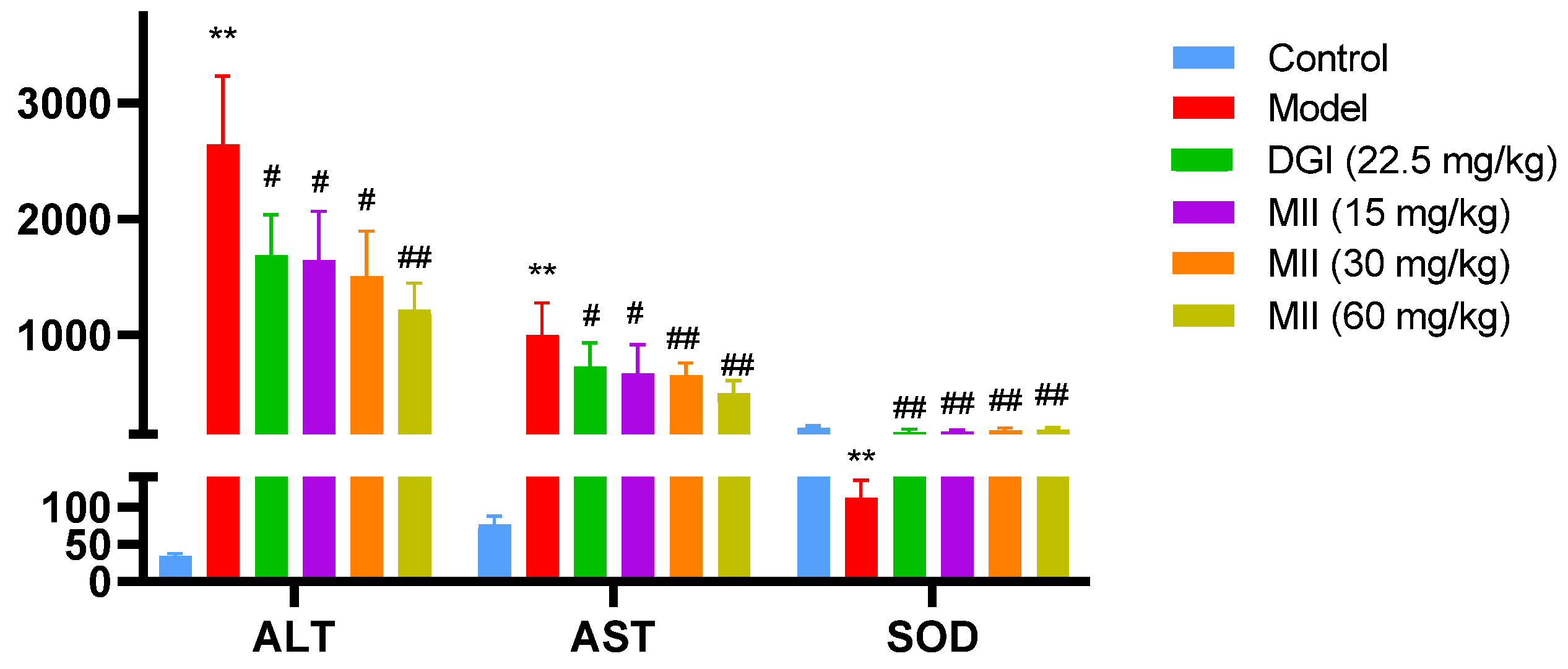
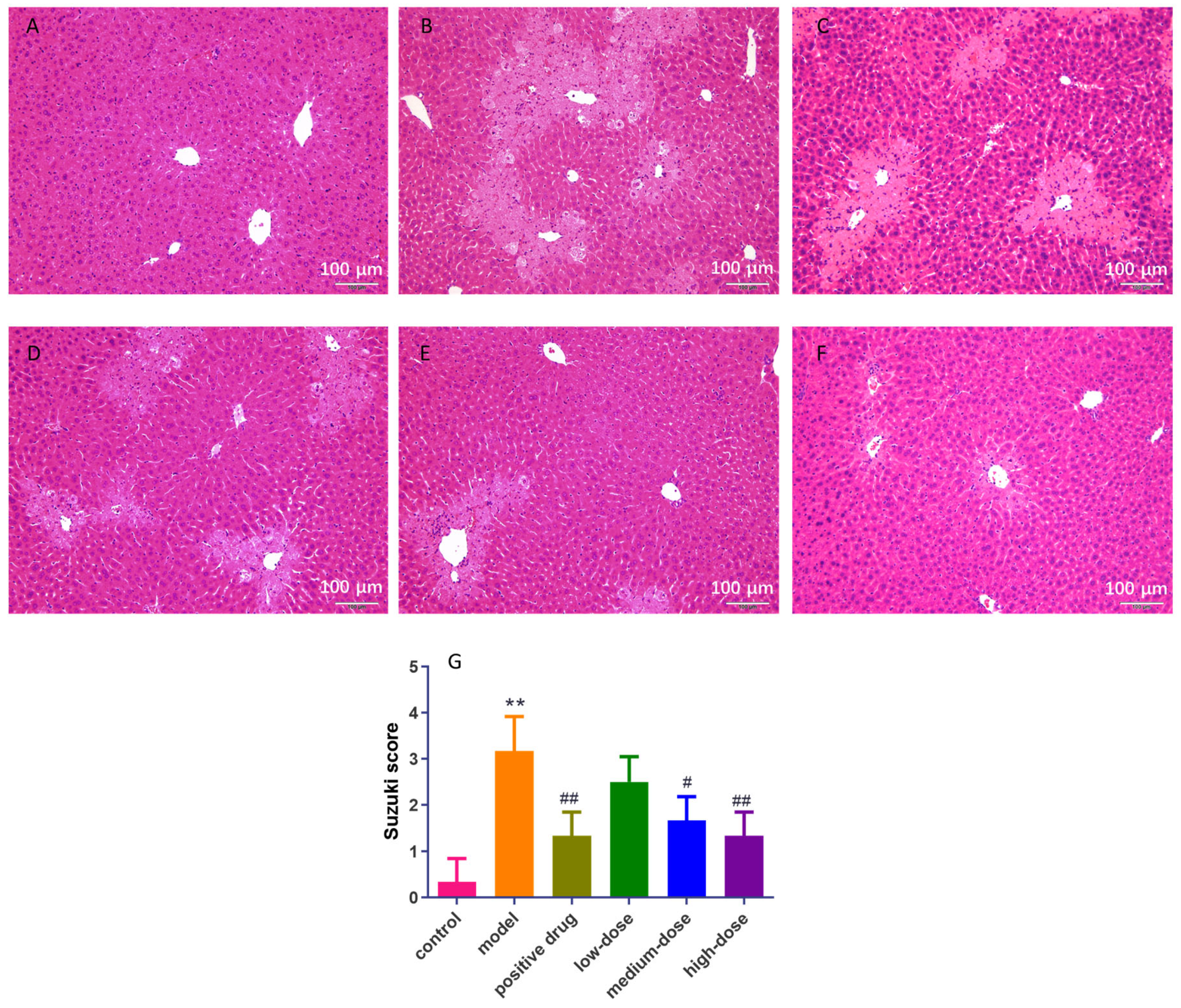
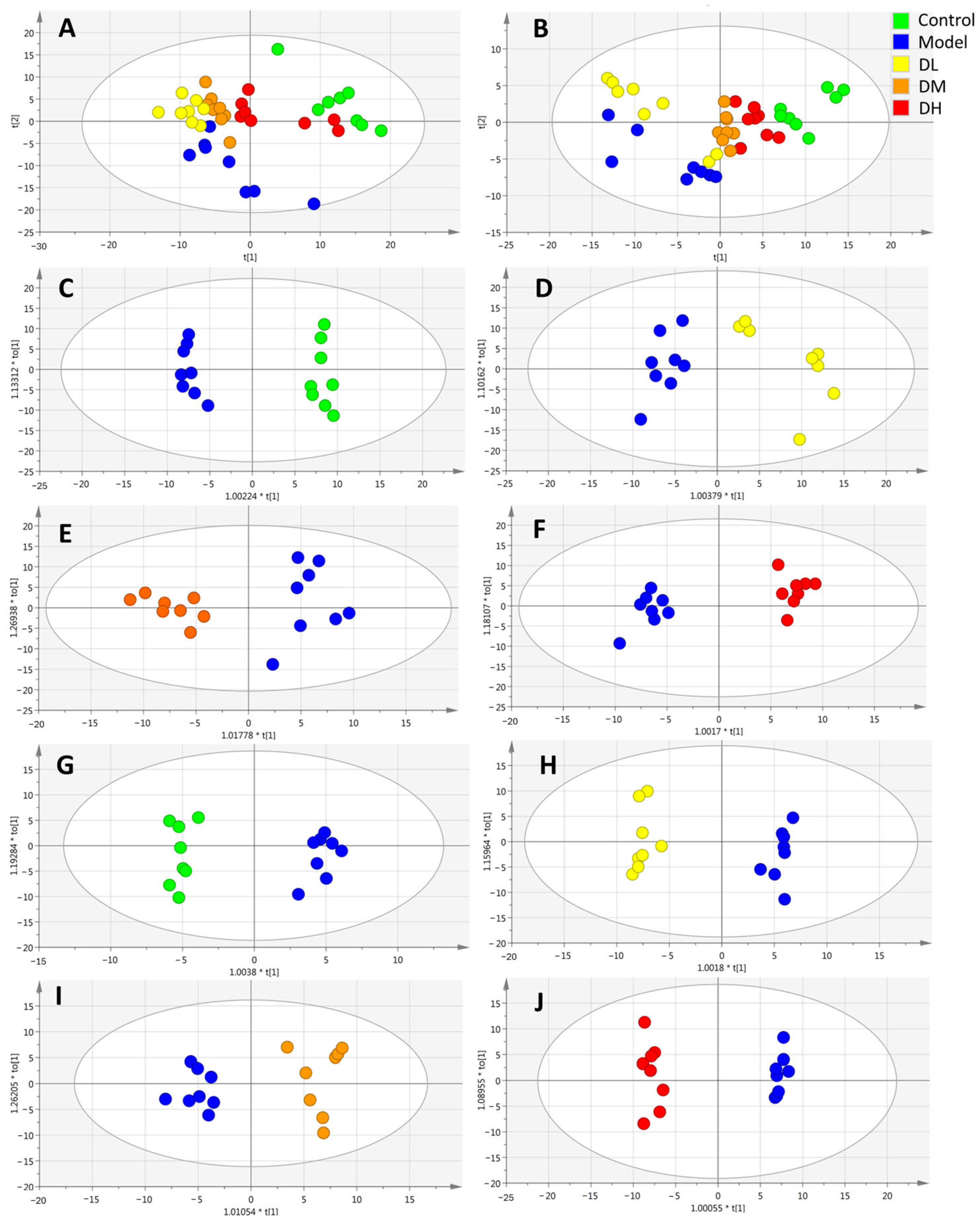
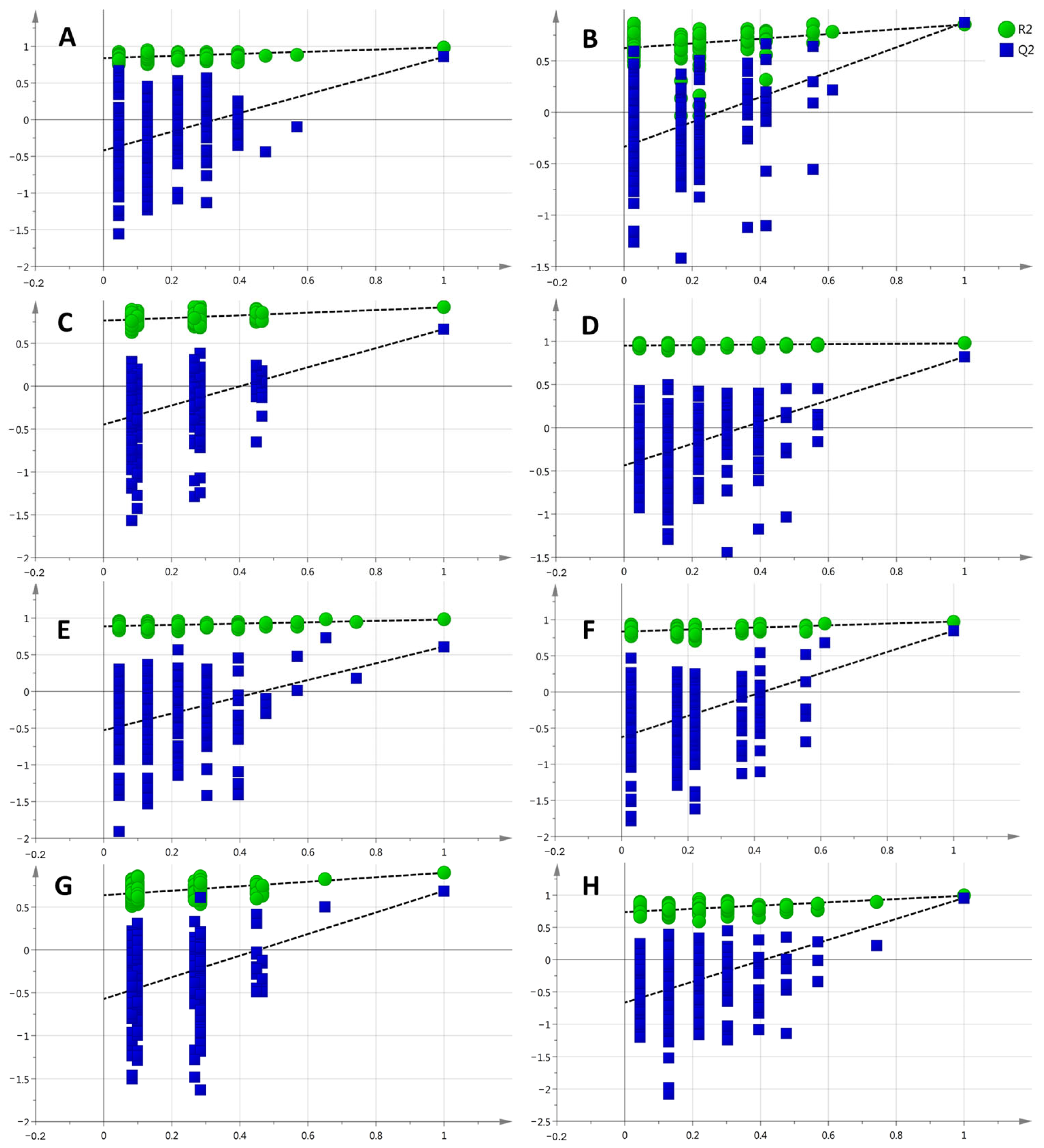

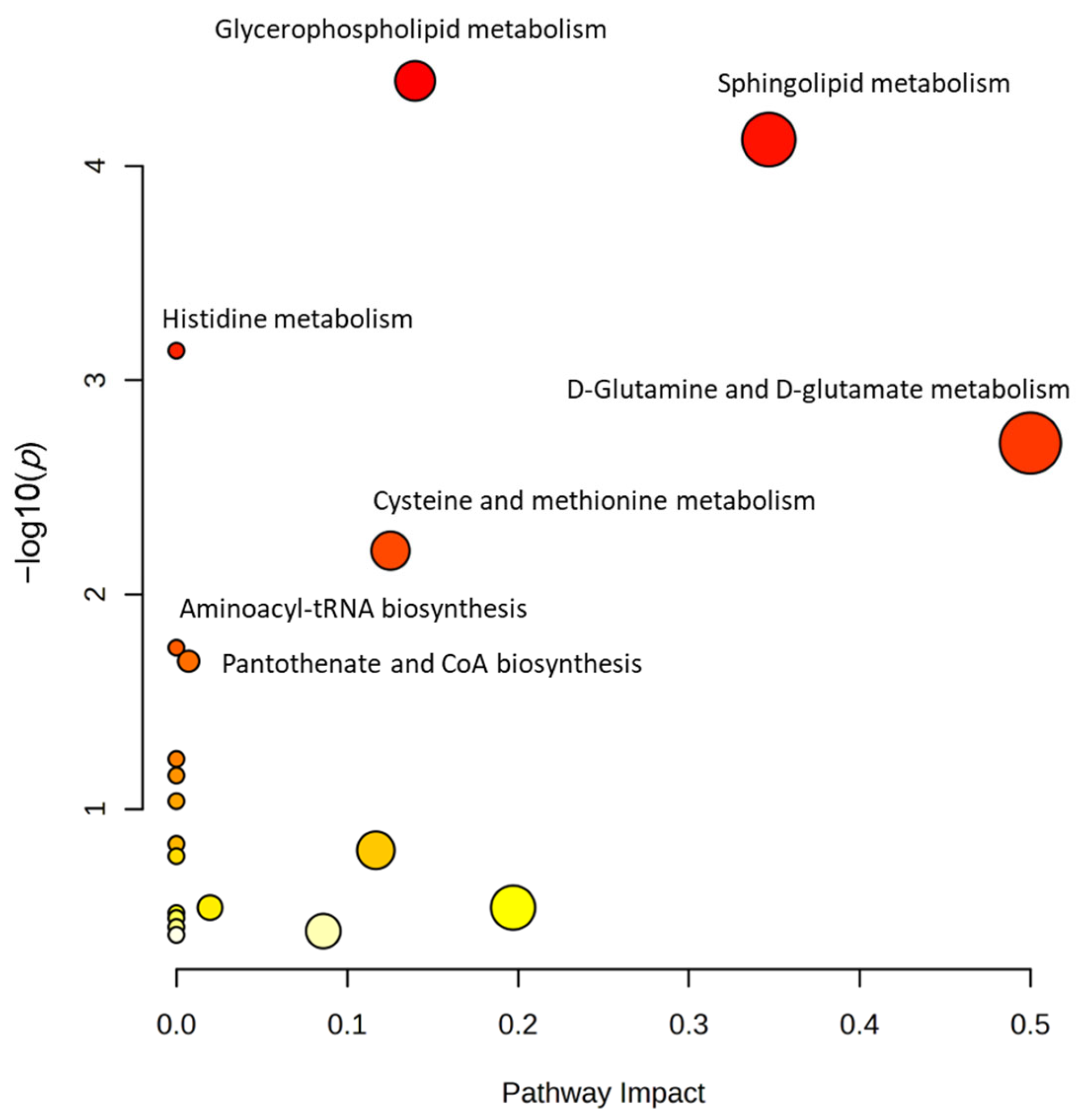
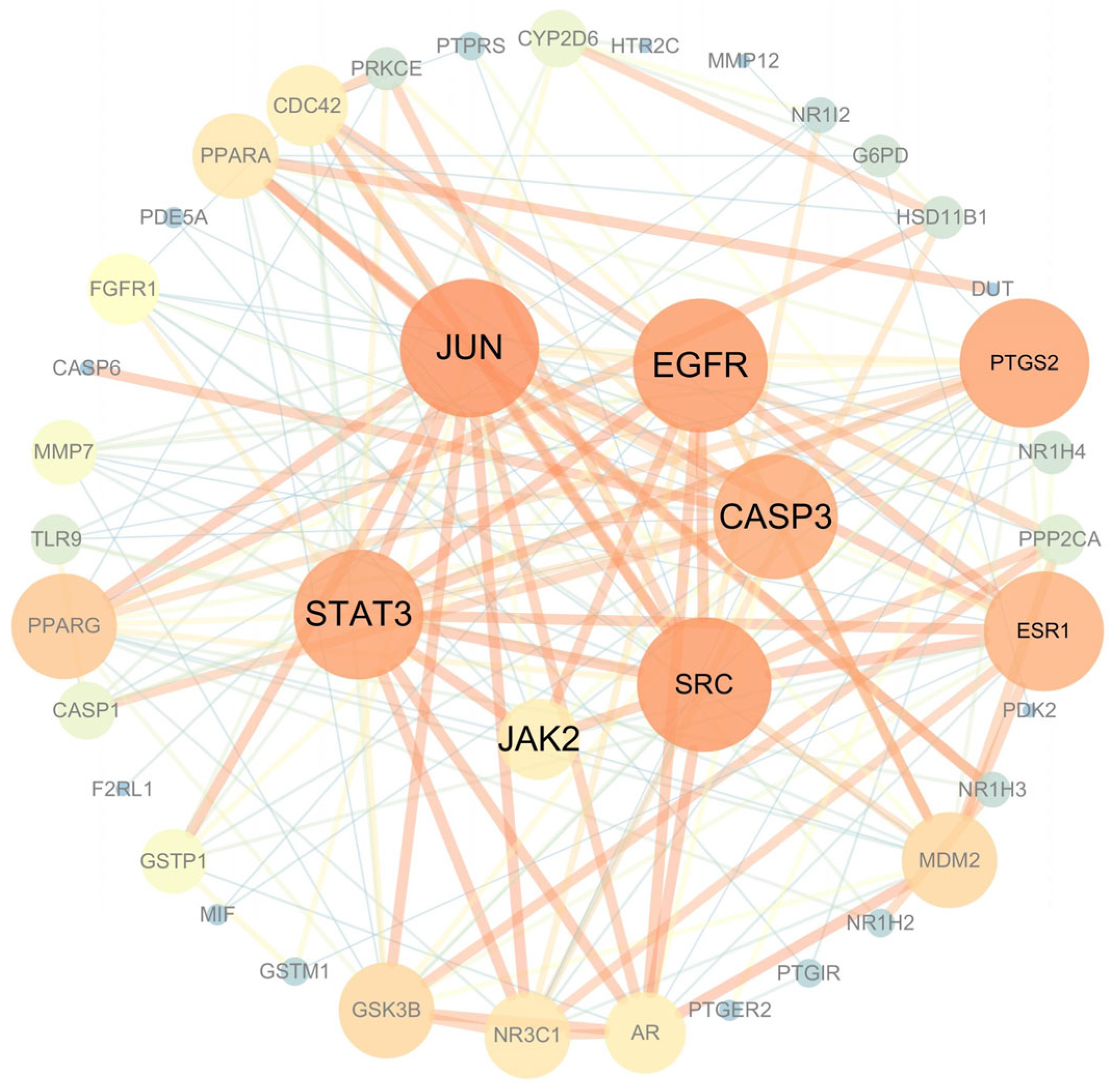
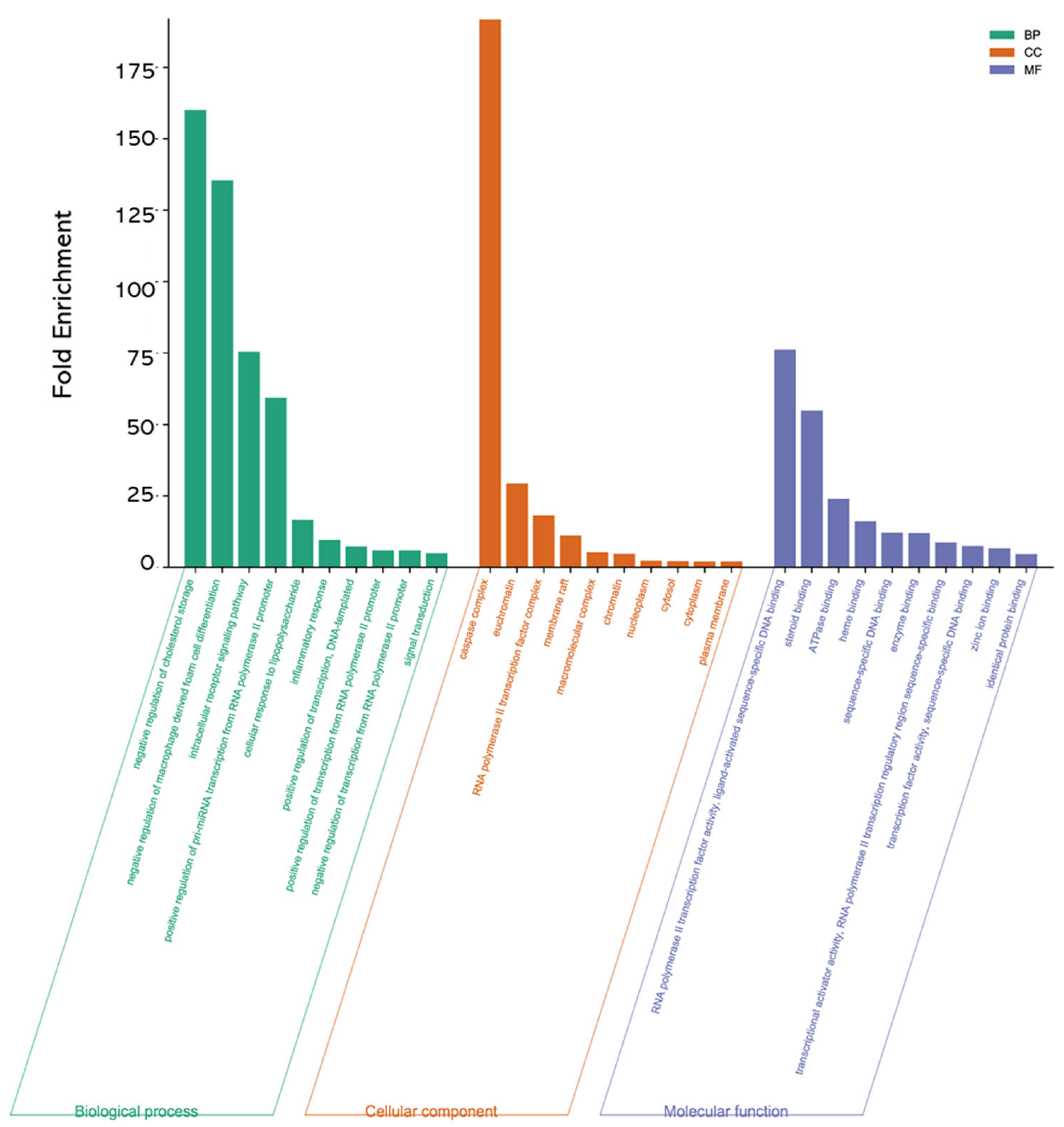

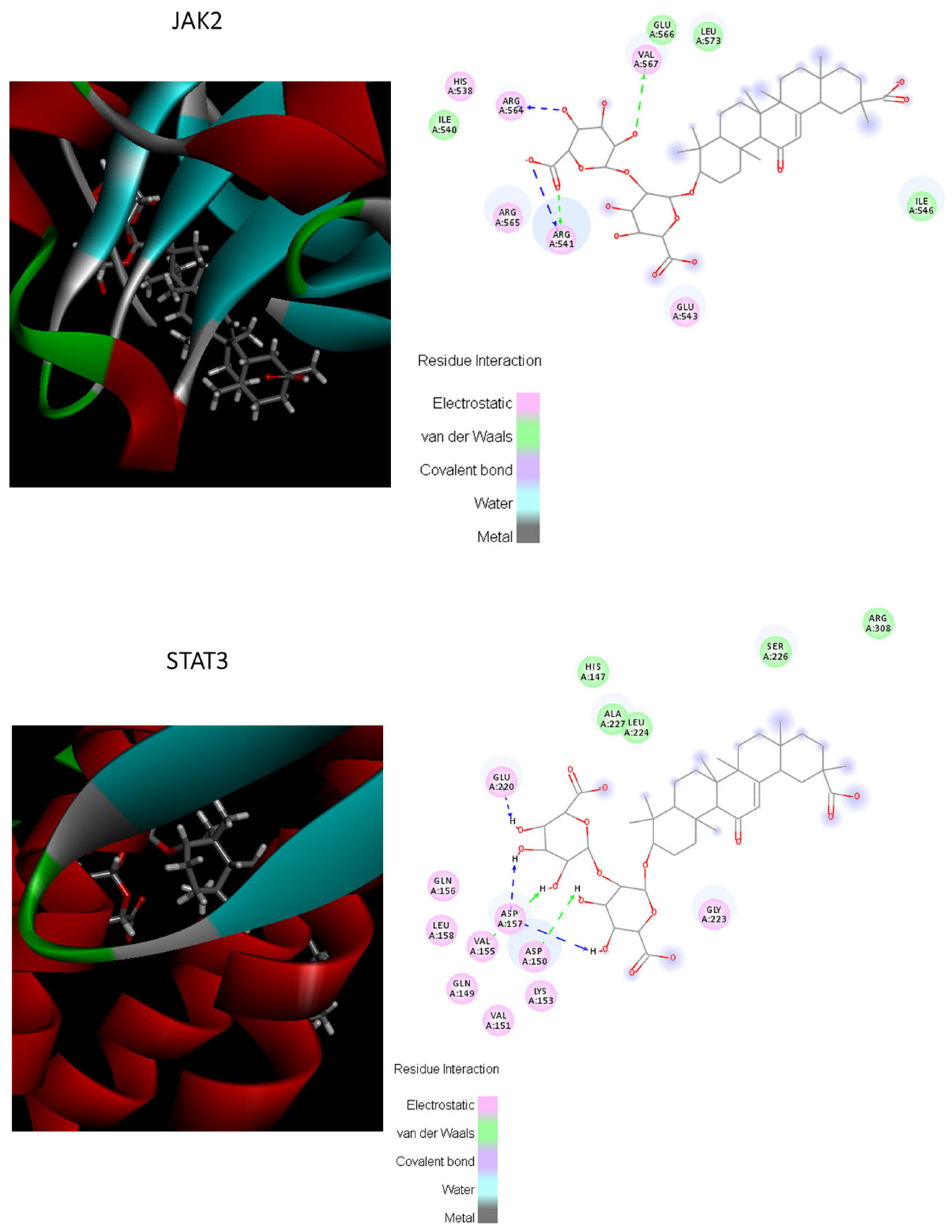
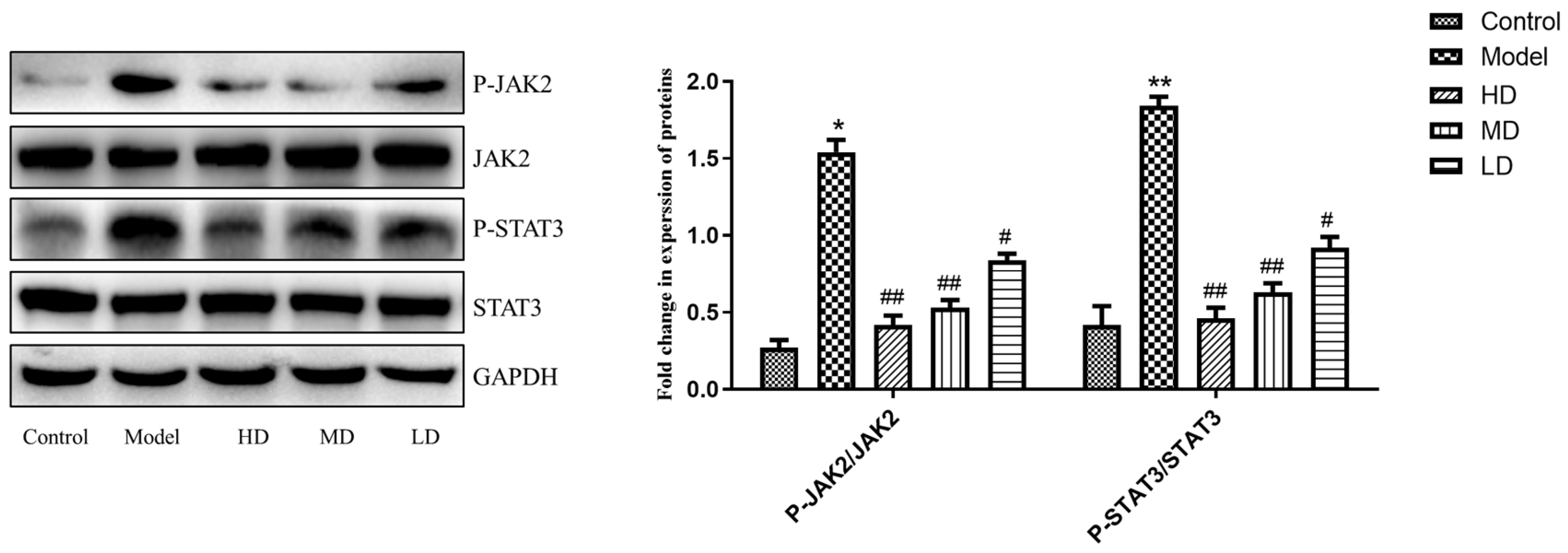
| No. | Match | RT (min) | m/z | Formula | Scan Mode | VIP | p | Model vs. Control | Dose vs. Model |
|---|---|---|---|---|---|---|---|---|---|
| 1 | 2,5-Dichloro-4-oxohex-2-enedioate | 1.28 | 226.9509 | C6H4Cl2O5 | Positive | 3.7 | 0.0000913 | up | down |
| 2 | Glutamate | 1.32 | 148.0604 | C5H9NO4 | Positive | 2.4 | 0.00126 | up | down |
| 3 | β-Guanidinopropionic acid | 1.49 | 130.0622 | C4H9N3O2 | Negative | 2.2 | 3.76 × 10−10 | up | down |
| 4 | γ-Glutamyl-β-cyanoalanine | 1.56 | 244.0928 | C9H13N3O5 | Positive | 4.3 | 0.000124 | up | down |
| 5 | Methacholine | 1.62 | 161.1410 | C8H18NO2 | Positive | 2.0 | 1.41 × 10−6 | up | down |
| 6 | L-Valine | 1.68 | 280.1391 | C11H21NO7 | Positive | 2.4 | 0.00155 | down | up |
| 7 | L-Methionine | 1.87 | 150.0583 | C5H11NO2S | Positive | 1.1 | 0.00395 | down | up |
| 8 | Pyrrolidonecarboxylic acid | 1.95 | 130.0499 | C5H7NO3 | Positive | 2.6 | 0.00776 | down | up |
| 9 | Cytosine | 2.01 | 112.0505 | C4H5N3O | Positive | 5.1 | 0.0285 | down | up |
| 10 | 3,5-Dihydroxybenzoic acid | 2.12 | 121.0295 | C7H6O2 | Negative | 3.6 | 0.0000357 | down | up |
| 11 | 2-Phenylacetamide | 2.20 | 136.0757 | C8H9NO | Positive | 3.9 | 6.12 × 10−12 | down | up |
| 12 | Aminocaproic acid | 2.32 | 130.0874 | C6H13NO2 | Negative | 3.1 | 0.00126 | down | up |
| 13 | 1-Acyl-sn-glycero-3-phosphoserine | 3.25 | 288.0479 | C7H14NO9P | Positive | 2.5 | 0.000773 | down | up |
| 14 | Imidazoleacetic acid | 3.41 | 125.0357 | C5H6N2O2 | Negative | 2.3 | 0.00051 | down | up |
| 15 | Citicoline | 3.58 | 513.1122 | C14H27N4NaO11P2 | Positive | 4.4 | 0.0134 | down | up |
| 16 | Pantothenic acid | 3.67 | 218.1034 | C9H17NO5 | Negative | 2.2 | 9.90 × 10−5 | down | up |
| 17 | 5-Methylthioadenosine | 3.94 | 298.0968 | C11H15N5O3S | Positive | 1.4 | 3.27 × 10−6 | up | down |
| 18 | 5-Methylthiopentanaldoxime | 4.12 | 148.0791 | C6H13NOS | Positive | 2.2 | 0.000336 | down | up |
| 19 | 1-Methylhistidine | 4.31 | 170.0924 | C7H11N3O2 | Positive | 2.7 | 1.23 × 10−6 | down | up |
| 20 | L-Cystine | 5.22 | 209.0591 | C6H12N2O4S | Positive | 4.8 | 2.23 × 10−4 | down | up |
| 21 | Sphinganine | 7.85 | 302.3054 | C18H39NO2 | Positive | 3.2 | 3.61 × 10−5 | up | down |
| 22 | Phytosphingosine | 7.91 | 318.3003 | C18H39NO3 | Positive | 3.2 | 1.39 × 10−5 | up | down |
| 23 | Dihydroceramide (d18:0/18:0) | 8.51 | 568.5663 | C36H73NO3 | Positive | 1.6 | 6.72 × 10−3 | down | up |
| 24 | Sphingosine 1-phosphate | 8.89 | 380.2560 | C18H38NO5P | Positive | 2.4 | 0.0000861 | down | up |
| 25 | α-Methylstyrene | 9.36 | 119.0855 | C9H10 | Positive | 3.1 | 2.11 × 10−8 | up | down |
| 26 | 2-Acyl-sn-glycero-3-phosphocholine | 9.40 | 543.3319 | C28H49NO7P | Positive | 3.5 | 0.00713 | down | up |
| 27 | LysoPC (18:1) | 9.41 | 495.3319 | C24H49NO7P | Positive | 1.8 | 2.31 × 10−4 | up | down |
| 28 | α-D-galactosyl undecaprenyl diphosphate | 9.86 | 1089.5919 | C61H102O12P2 | Positive | 5.3 | 2.10 × 10−5 | down | up |
| 29 | PC (16:0/16:0) | 12.37 | 734.5694 | C40H80NO8P | Positive | 5.6 | 0.001266 | up | down |
| Name | Total | Hits | p | FDR | Impact |
|---|---|---|---|---|---|
| Glycerophospholipid metabolism | 36 | 5 | 5.36 × 10−5 | 0.0039812 | 0.13975 |
| Sphingolipid metabolism | 21 | 4 | 9.48 × 10−5 | 0.0039812 | 0.34686 |
| Histidine metabolism | 16 | 3 | 8.61 × 10−4 | 0.024097 | 0 |
| Glutamine and glutamate metabolism | 6 | 2 | 0.00220 | 0.046115 | 0.5 |
| Cysteine and methionine metabolism | 8 | 2 | 0.00404 | 0.067834 | 0 |
| Aminoacyl biosynthesis | 33 | 3 | 0.00732 | 0.10244 | 0.12535 |
| Biosynthesis of pantothenic acid and coenzyme A | 48 | 3 | 0.02067 | 0.23835 | 0 |
Disclaimer/Publisher’s Note: The statements, opinions and data contained in all publications are solely those of the individual author(s) and contributor(s) and not of MDPI and/or the editor(s). MDPI and/or the editor(s) disclaim responsibility for any injury to people or property resulting from any ideas, methods, instructions or products referred to in the content. |
© 2023 by the authors. Licensee MDPI, Basel, Switzerland. This article is an open access article distributed under the terms and conditions of the Creative Commons Attribution (CC BY) license (https://creativecommons.org/licenses/by/4.0/).
Share and Cite
Zhang, Y.; Li, H.; Liu, X.; Wang, Q.; Zhao, D.; Su, M.; Jia, Z.; Shen, S. Integrating Metabolomics and Network Pharmacology to Decipher the Hepatoprotective Effect Mechanisms of Magnesium Isoglycyrrhizinate Injection. Curr. Issues Mol. Biol. 2024, 46, 279-298. https://doi.org/10.3390/cimb46010019
Zhang Y, Li H, Liu X, Wang Q, Zhao D, Su M, Jia Z, Shen S. Integrating Metabolomics and Network Pharmacology to Decipher the Hepatoprotective Effect Mechanisms of Magnesium Isoglycyrrhizinate Injection. Current Issues in Molecular Biology. 2024; 46(1):279-298. https://doi.org/10.3390/cimb46010019
Chicago/Turabian StyleZhang, Yihua, Hui Li, Xueli Liu, Qiang Wang, Dong Zhao, Ming Su, Zhixin Jia, and Shigang Shen. 2024. "Integrating Metabolomics and Network Pharmacology to Decipher the Hepatoprotective Effect Mechanisms of Magnesium Isoglycyrrhizinate Injection" Current Issues in Molecular Biology 46, no. 1: 279-298. https://doi.org/10.3390/cimb46010019
APA StyleZhang, Y., Li, H., Liu, X., Wang, Q., Zhao, D., Su, M., Jia, Z., & Shen, S. (2024). Integrating Metabolomics and Network Pharmacology to Decipher the Hepatoprotective Effect Mechanisms of Magnesium Isoglycyrrhizinate Injection. Current Issues in Molecular Biology, 46(1), 279-298. https://doi.org/10.3390/cimb46010019






